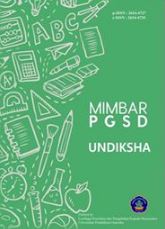The Oppemei Model on Creative Thinking Skills Reviewing From Self-Efficacy of Students in Science Learning
DOI:
https://doi.org/10.23887/jjpgsd.v11i2.49438Keywords:
OPEMEI Model, Creative Thinking Skills, Self EfficacyAbstract
The The current problem is that it is still very difficult to develop creative thinking skills and self-efficacy in children. This is because there is still a high sense of wanting to win alone and limited learning time at school. The main aim of this research is to analyze the OPPEMEI model for creative thinking skills in terms of the self-efficacy of fourth grade elementary school students in learning science. The population of this research is all 186 grade IV students. This type of research is a quasi-experiment with a non-randomized design.PosttestOnly Control GroupDesignand 2x2 factorial as the analysis design. The classes used as samples were determined using random sampling techniques. Data collection methods use questionnaires and tests. The instrument uses questionnaires and question sheets. Data analysis techniques are descriptive qualitative and descriptive quantitative using two-way analysis of variance (ANOVA). The research results show that there are differences in creative thinking skills between students who follow the OPPEMEI learning model and students who follow the conventional learning model. There are differences in creative thinking skills, in groups of students who have high self-efficacy who follow the OPPEMEI learning model and students who follow conventional learning models. There are differences in creative thinking skills, in the group of students who have low self-efficacy who follow the OPPEMEI learning model and students who follow the conventional learning model. It was concluded that there was an interaction effect between the learning model and self-efficacy on students' creative thinking skills in science subjects.
References
Adnyani, N. K. M., Pudjawan, K., & Japa, I. G. N. (2020). Motivasi dan Hasil Belajar IPA dalam Pembelajaran Scramble Berbantuan Kartu Pertanyaan. Jurnal Ilmiah Sekolah Dasar, 4(2), 270. https://doi.org/10.23887/jisd.v4i2.25622. DOI: https://doi.org/10.23887/jisd.v4i2.25622
Agustiana, I.G.A.T., Agustini, R., Ibrahim, M., & Tika, I. N. (2020). Efektivitas model OPPEMEI untuk meningkatkan kemampuan berpikir kreatif mahasiswa. Journal of Education Technology, 4(2), 150–160. https://doi.org/10.23887/jet.v4i2.25343. DOI: https://doi.org/10.23887/jet.v4i2.25343
Agustiana, I Gusti Ayu Tri, Agustini, R., Ibrahim, M., & Tika, I. N. (2020a). Perangkat Pembelajaran (RPS dan SAP) IPA Model (OPPEMEI) untuk Meningkatkan Keterampilan Berpikir Kreatif Mahasiswa PGSD. Jurnal Ilmiah Sekolah Dasar, 4(2), 309–323. https://doi.org/10.23887/jisd.v4i2.25190. DOI: https://doi.org/10.23887/jisd.v4i2.25190
Agustiana, I Gusti Ayu Tri, Agustini, R., Ibrahim, M., & Tika, I. N. (2020b). The Effect of OPPEMEI Model on Students’ Creative Thinking Skill and Cognitive Learning Achievement. In International Joint Conference on Science and Engineering (IJCSE 2020). https://doi.org/10.2991/aer.k.201124.040. DOI: https://doi.org/10.2991/aer.k.201124.040
Akkuzu, N., & Uyulgan, M. A. (2016). An epistemological inquiry into organic chemistry education: exploration of undergraduate students’ conceptual understanding of functional groups. Chem. Educ. Res. Pract, 17(1), 36–57. DOI: https://doi.org/10.1039/C5RP00128E
Alfaiz, A., Hidayat, H., Yandri, H., Tina, A., Sari, L., Sendayu, F. S., Suarja, S., & Arjoni, A. (2021). Identification of Perceived Self-Efficacy to Predict Student ’ s Awareness in Career Readiness. Islamic Guidance and Counseling Journal, 4. https://doi.org/0000-0003-1226-0443. DOI: https://doi.org/10.25217/igcj.v4i1.933
Amalia, Y., Duskri, M., & Ahmad, A. (2015). Penerapan Model Eliciting Activities untuk Meningkatkan Kemampuan Berpikir Kreatif Matematis dan Self Confidence Siswa SMA. Jurnal Didaktik Matematika, 2(2), 38–48. https://doi.org/10.24815/jdm.v2i2.2813.
Blass, L., Williams, J., & Robinson, A. (2016). 21st Century Reading 4 : Creative Thinking and Reading with TED Talks. 20(2), 20–22.
Botha, E., Helminen, M., Kaunonen, M., Lubbe, W., & Joronen, K. (2020). Mothers’ parenting self-efficacy, satisfaction and perceptions of their infants during the first days postpartum. Midwifery, 88(1), 102760. https://doi.org/10.1016/j.midw.2020.102760. DOI: https://doi.org/10.1016/j.midw.2020.102760
Çam, A., & Geban, Ö. (2017). Effectiveness of case-based learning instruction on pre-service teachers’ chemistry motivation and attitudes toward chemistry. Research in Science & Technological Education, 35(1), 74–87. https://doi.org/10.1080/02635143.2016.1248927. DOI: https://doi.org/10.1080/02635143.2016.1248927
Chen, S. D., Yu, Y., Li, X. K., Chen, S. Q., & Ren, J. (2021). Parental Self-Efficacy and Behavioral Problems in Children with Autism During COVID-19: A Moderated Mediation Model of Parenting Stress and Perceived Social Support. Psychology Research and Behavior Management, 14(1), 1291–1301. https://doi.org/10.2147/PRBM.S327377. DOI: https://doi.org/10.2147/PRBM.S327377
Dilla, S. C., Hidayat, W., & Rohaeti, E. E. (2018). Faktor Gender dan Resiliensi dalam Pencapaian Kemampuan Berpikir Kreatif Matematis Siswa SMA. Journal of Medives : Journal of Mathematics Education IKIP Veteran Semarang, 2(1), 129. https://doi.org/10.31331/medives.v2i1.553. DOI: https://doi.org/10.31331/medives.v2i1.553
Febriani, S., & Ratu, N. (2018). Profil Proses Berpikir Kreatif Matematis Siswa dalam Pemecahan Masalah Open-Ended Berdasarkan Teori Wallas. MOSHARAFA: Jurnal Pendidikan Matematik, 7(1). https://doi.org/10.31980/mosharafa.v7i1.340. DOI: https://doi.org/10.31980/mosharafa.v7i1.340
Goudsouzian, L. ., Riola, P., Ruggles, K., Gupta, P., & Mondoux, M. . (2018). Integrating Cell and Molecular Biology Concepts: Comparing Learning Gains and Self-Efficacy in Corresponding Live and Virtual Undergraduate Laboratory Experiences. Biochemistry and Molecular Biology Education, 46(4), 361–372. https://doi.org/10.1002/bmb.21133. DOI: https://doi.org/10.1002/bmb.21133
Haack, J. A., & Hutchison, J. E. (2016). Green Chemistry Education: 25 Years of Progress and 25 Years Ahead. ACS Sustainable Chemistry & Engineering, 4(11), 5889–5896. https://doi.org/10.1021/acssuschemeng.6b02069. DOI: https://doi.org/10.1021/acssuschemeng.6b02069
Hagger, M. S., & Chatzisarantis, N. L. D. (2016). The Trans-Contextual Model of Autonomous Motivation in Education: Conceptual and Empirical Issues and Meta-Analysis. Review of Educational Research, 86(2), 360–407. https://doi.org/10.3102/0034654315585005. DOI: https://doi.org/10.3102/0034654315585005
Marliani. (2015). Peningkatan Kemampuan Berpikir Kreatif Matematis Siswa melalui Model Pembelajaran Missouri Mathematics Project (MMP). Jurnal Ilmiah Pendidikan MIPA, 5(1), 14–25. https://doi.org/10.30998/formatif.v5i1.166. DOI: https://doi.org/10.30998/formatif.v5i1.166
Mireles-Rios, R., & Becchio, J. A. (2018). The evaluation process, administrator feedback, and teacher self-efficacy. Journal of School Leadership, 28(4), 462–487. https://doi.org/10.1177/105268461802800402. DOI: https://doi.org/10.1177/105268461802800402
Ningrum, P. (2016). Meningkatkan Keaktifan Dan Kemampuan Berpikir Kreatif Melalui Pembelajaran Kolaboratif Berbasis Masalah Materi Kelarutan Dan Hasil Kali Kelarutan (Ksp) Siswa Kelas Xi SMA Negeri 10 Semarang. Jurnal Pendidikan Sains, 04, 17–28. https://doi.org/10.26714/jps.4.1.2016.17-28.
Nuranggraeni, E., Effendi, K. N. S., & Sutirna, S. S. (2020). Analisis Kemampuan Berpikir Kreatif Matematis Ditinjau dari Kesulitan Belajar Siswa. JP3M (Jurnal Penelitian Pendidikan dan Pengajaran Matematika), 6(2), 107–114. https://doi.org/10.37058/jp3m.v6i2.2066. DOI: https://doi.org/10.37058/jp3m.v6i2.2066
Peleg, R. (2009). Proof - Teachers’ views on implementing storytelling as a way to motivate inquiry learning in high-school chemistry teaching. Chemistry Education Research and Practice, 24(1), 61–65. https://doi.org/10.1039/C6RP00215C. DOI: https://doi.org/10.1039/C6RP00215C
Putri, C. A., Munzir, S., & Abidin, Z. (2019). Kemampuan Berpikir Kreatif Matematis Siswa melalui Model Pembelajaran Brain-Based Learning. Jurnal Didaktik Matematika Universitas Syiah Kuala, 6(1), 12–27. https://doi.org/10.24815/jdm.v6i1.9608. DOI: https://doi.org/10.24815/jdm.v6i1.9608
Qistina, M., Alpusari, M., Noviana, E., & Hermita, N. (2019). Pengembangan Multimedia Interaktif Mata Pelajaran Ipa Kelas Ivc Sd Negeri 034 Taraibangun Kabupaten Kampar. Primary: Jurnal Pendidikan Guru Sekolah Dasar, 8(2), 148. https://doi.org/10.33578/jpfkip.v8i2.7649. DOI: https://doi.org/10.33578/jpfkip.v8i2.7649
Rahmadani, A. F., Hendracipta, N., & Andriana, E. (2021). Penerapan Model Pembelajaran Visualization, Auditory, Kinestetic (Vak) Terhadap Kemampuan Berpikir Kreatif Siswa Pada Mata Pelajaran IPA. Primary: Jurnal Pendidikan Guru Sekolah Dasar, 10(2). https://doi.org/10.33578/jpfkip.v10i2.8089. DOI: https://doi.org/10.33578/jpfkip.v10i2.8089
Redifer, J. L., Bae, C. L., & Zhao, Q. (2021). Self-Efficacy and Performance Feedback: Impacts on Cognitive Load During Creative Thinking. Learning and Instruction, 71(June 2020), 101395. https://doi.org/10.1016/j.learninstruc.2020.101395. DOI: https://doi.org/10.1016/j.learninstruc.2020.101395
Rohana, R., & Wahyudin, D. (2017). Project based learning untuk meningkatkan berpikir kreatif siswa SD pada materi makanan dan kesehatan. Jurnal Penelitian Pendidikan, 16(3), 235–243. DOI: https://doi.org/10.17509/jpp.v16i3.4817
Sa’pang, A. W., & Purbojo, R. (2020). Teacher`s self-efficacy, understanding of students` characters, and understanding of the 21st century skills as predictors of facilitator type of teaching style. Jurnal Psikologi Ulayat: Indonesian Journal of Indigenous Psychology, 7(2), 192–211. https://doi.org/10.24854/JPU108. DOI: https://doi.org/10.24854/jpu108
Safithri, R., Syaiful, S., & Huda, N. (2021). Pengaruh Penerapan Problem Based Learning (PBL) dan Project Based Learning (PjBL) Terhadap Kemampuan Pemecahan Masalah Berdasarkan Self Efficacy Siswa. Jurnal Cendekia : Jurnal Pendidikan Matematika, 5(1), 335–346. https://doi.org/10.31004/cendekia.v5i1.539. DOI: https://doi.org/10.31004/cendekia.v5i1.539
Schmidt, A. L. (2010). The Battle for creativity: Frontier in science and science education. A Taxonomy of Learning, Teaching, and Assessing, Revision of Bloom’s Taxonomy of Educational Objectives, 32, 1016–1019 ,. DOI: https://doi.org/10.1002/bies.201000092
Suparmi, N. W. (2018). Hasil Belajar, Pemahaman Konsep Dan Berpikir Kreatif Siswa Dalam Pembelajaran Inkuiri Bebas Dan Inkuiri Terbimbing. Journa. DOI: https://doi.org/10.23887/jet.v2i4.16548
Downloads
Published
How to Cite
Issue
Section
License
Copyright (c) 2023 I Gusti Ayu Tri Agustiana

This work is licensed under a Creative Commons Attribution-ShareAlike 4.0 International License.
Authors who publish with the Mimbar PGSD Undiksha agree to the following terms:
- Authors retain copyright and grant the journal the right of first publication with the work simultaneously licensed under a Creative Commons Attribution License (CC BY-SA 4.0) that allows others to share the work with an acknowledgment of the work's authorship and initial publication in this journal.
- Authors are able to enter into separate, additional contractual arrangements for the non-exclusive distribution of the journal's published version of the work (e.g., post it to an institutional repository or publish it in a book), with an acknowledgment of its initial publication in this journal.
- Authors are permitted and encouraged to post their work online (e.g., in institutional repositories or on their website) prior to and during the submission process, as it can lead to productive exchanges, as well as earlier and greater citation of published work. (See The Effect of Open Access)













